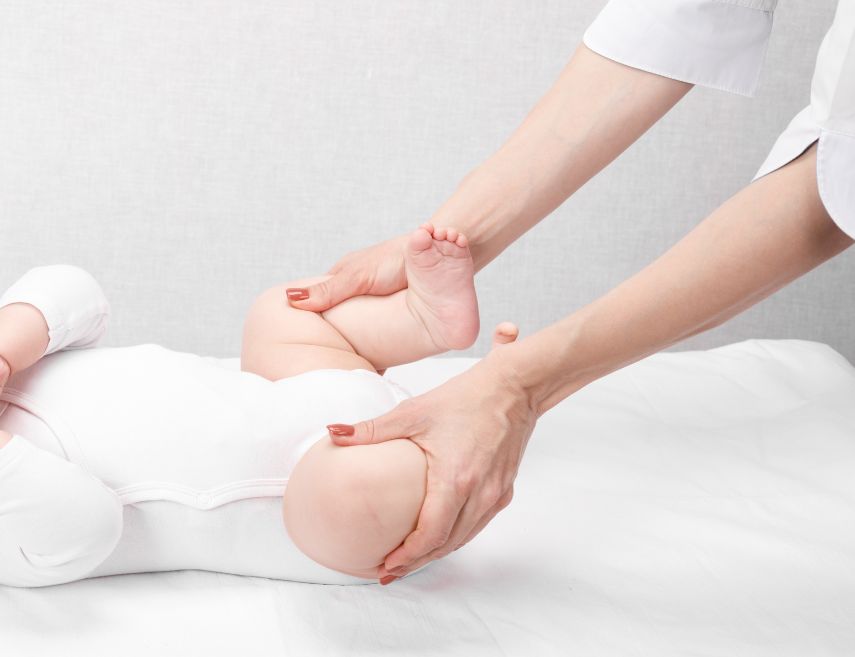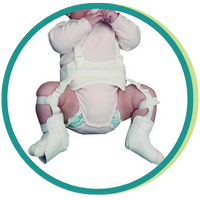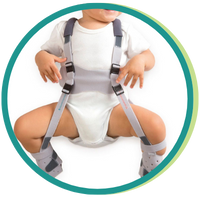
How to Detect and Treat Hip Dysplasia Baby
What is Hip Dysplasia Baby?
Hip dysplasia baby is a condition that affects the normal development of the joint between the femur and the pelvis of the baby. This condition, which can arise during pregnancy or shortly after birth, prevents the joint from forming correctly, resulting in instability ranging from mild to severe.
The hip joint functions as a “ball and socket,” essential for stability and movement. In babies with hip dysplasia baby, the ball of the femur may not fit properly into the socket of the pelvis, causing instability, subluxation (partial dislocation), or even complete dislocation.
If untreated early, hip dysplasia baby can lead to motor development issues, difficulties in movement, and even health problems in adulthood, such as osteoarthritis.
What Are the Degrees of Hip Dysplasia Baby?
The degrees of hip dysplasia baby help classify the severity of the condition. These are the most common:
- Mild Dysplasia: Characterized by slight joint instability, but the femur remains in the socket.
- Subluxation: The femur is partially out of the socket, losing full contact with the pelvis.
- Complete Dislocation: The femur is completely displaced from the pelvis, requiring immediate treatment.
The severity of the dysplasia influences the type of treatment required, emphasizing the importance of early diagnosis for better outcomes.
Risk Factors for Hip Dysplasia Baby
Although this condition can occur in any baby, certain risk factors increase its likelihood:
- Family History: If there is a history of hip dysplasia baby in the family, the risk is higher.
- Breech Presentation: Babies born in a breech position (bottom-first) are more likely to develop the condition.
- Firstborn: The risk of hip dysplasia baby is higher in firstborns, possibly due to the limited space in the womb.
- Female Gender: Girls are more prone to developing hip dysplasia baby due to hormonal factors.
How to Detect Hip Dysplasia Baby?
Early detection of hip dysplasia baby is crucial for effective treatment. There are some signs that parents and healthcare professionals should be aware of, as well as clinical diagnostic methods:
Warning Signs
- Difference in leg length.
- Asymmetry in the skin folds on the thighs or buttocks.
- Difficulty spreading the baby’s legs during diaper changes.
- Clicking or popping sounds when moving the hip joints.
Diagnostic Tests
Hip ultrasound is the most commonly used diagnostic method to confirm hip dysplasia baby. This test should be performed in the first weeks or months of life, especially for babies with risk factors.
Where to Do It? Hip ultrasounds are performed in hospitals, pediatric clinics, or specialized centers. It’s important to choose a facility experienced in this type of test, such as pediatric orthopedic units.
Treatment Options for Hip Dysplasia Baby
The treatment for hip dysplasia baby depends on the severity of the condition and the baby’s age at the time of diagnosis. Here are the most common options:
1. Use of Hip Abduction Braces
Hip abduction braces are devices that help keep the baby’s legs in an optimal position, properly aligning the femur with the pelvis socket. This non-invasive method is generally the initial treatment recommended for babies with dysplasia.
✔ Recommended Products:
2. Clothing for Babies with Hip Dysplasia Baby
Choosing the right clothing for babies with hip dysplasia baby plays a crucial role in ensuring comfort during brace use. Loose clothing, such as rompers or pants with elastic waists, allows greater mobility and avoids pressure on the device.
Tip: Opt for clothing with front or side buttons to make diaper changes easier without removing the brace.
3. Surgery (In Severe Cases)
In severe cases or when other treatments fail, surgical intervention may be necessary to correct the joint. After surgery, the baby may need casts or immobilization devices to ensure proper recovery.
Tips for Caring for a Baby with Hip Dysplasia Baby
- Follow Medical Recommendations: Ensure the brace is used correctly and for the prescribed duration.
- Be Careful When Carrying the Baby: Use ergonomic baby carriers that allow a natural “M” position with the legs spread apart.
- Avoid Tight Swaddling: Swaddling should allow the legs to move freely.
- Prioritize Comfort: Choose clothing and accessories that accommodate the brace without causing discomfort.
Preventing Hip Dysplasia Baby
Although it’s not always possible to prevent hip dysplasia baby, parents can take measures to reduce the risk:
- Perform Early Screenings: Ensure the baby undergoes a hip ultrasound in the first weeks of life, especially if there are risk factors.
- Choose Suitable Products: Use clothing, transport devices, and chairs that promote an ergonomic hip position.
- Avoid Excessive Pressure on the Legs: Allow the baby enough space to move their legs freely, promoting healthy joint development.
Long-Term Impact on the Baby’s Health
Early diagnosis and treatment of hip dysplasia baby are essential for ensuring healthy development. Babies treated appropriately recover well and develop normally without limitations.
On the other hand, untreated hip dysplasia baby can lead to chronic pain, mobility issues, or even more complex surgeries in adulthood.
Where to Buy Products for Treating Hip Dysplasia Baby?
At Loja Ortopédica, you can find specialized products such as hip abduction braces that help safely and effectively correct hip dysplasia baby.
Conclusion
Hip dysplasia baby is a condition that requires attention and early care. From performing a hip ultrasound to using abduction braces, there are several effective solutions to ensure the baby’s healthy development.
If you suspect your baby might have hip dysplasia baby, seek medical advice and invest in suitable products like those available at Loja Ortopédica. Early care can make all the difference in your baby’s quality of life!






No Comments